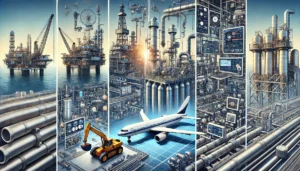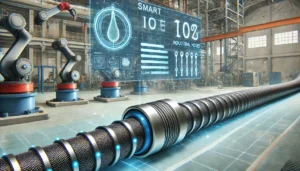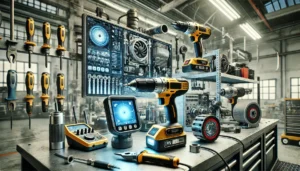Choosing the right valve for industrial uses is fundamental for the expected performance and safe operation of the system, as well as its durability. Valves are control elements that influence the movement of fluids, gases and even slurries in a pipeline. The selection is made depending on the specific criteria that are prevalent for each case, which means it shall be done with caution. Below is a detailed process to help you make a sound judgement:
1. Identify the Operational Nature of the Valve
This is the first step to choosing a valve and concerns exactly what it will be doing. Some common ones are as follows:
- On/Off Control: Valves such as gate or ball valves are perfect for starting and stopping fluid flow.
- Flow Regulation: Globe or needle valves are suitable for moderate and precise controlled fluid flow.
- Pressure Relief: Excessive pressure caused by a system failure is constrained within safety valves.
- Non-Return Flow: Fluid flow is permitted in one direction only by check valves, which prevents backflow.
Defining the non-existent purpose of concern narrows the types of valves for the application in question.
2. Examine the Nature of the Medium
The characteristics of the medium, gas or liquid, that will be controlled form the basis of selection of the valve:
- Corrosiveness: For corrosive substances, stainless steel or some special alloys are to be used to avoid degradation.
- Viscosity: The increase in the thickness of certain fluids may provide the need for the opening of valves to be wider or have special designs for better flow control.
- Temperature and Pressure: The application of valves at higher temperatures and pressures has a very critical requirement of a certain degree of strength of a specific amount of those materials that compromises integrity.
3. Consider Valve Material Compatibility
It is of critical importance to choose a valve suitable for the medium and the environment of operation. This is done by using valves constructed from the appropriate material:
- Metals: These materials differ in strength, corrosion resistance, durability to higher and moderate temperatures and pressure: brass, bronze, stainless steel, and carbon steel.
- Plastics: Valves of PVC, CPVC and PTFE are recommended for certain chemicals of lower temperature but not suitable for high pressure.
Material compatibility is a primary concern in order to avoid system failure due to the loss of integrity.
4. Evaluate the Valve Size and Flow Requirements
The valve has to be the right size in order to operate next to:
- Flow Rate: The rate of flow has to be established in advance and valves selected for the desired maximum flow with low pressure drop.
- Pipe Diameter: The diameter of the pipe has to be the same as the valve opening in order for the flow to be smooth and un turbulent.
Sizing the valves accurately is the major requirement to make sure that the valve operates in an optimal condition within the system.
5. Choose the Actuation Technique
Valves are work by hand or through a variety of techniques:
- Manual: For situations in which automation is not needed, hand-operated valves are easy and inexpensive.
- Pneumatic: Suitable for remote or unsafe locations since it dependably and quickly utilizes compressed air.
- Electric: For intricate automated tasks, electric actuators can be incorporated with automated systems and purposes each provide excellent control.
Control, accessibility, and how it will fit in with the existing systems are some of the issues that need to be considered before deciding on a specific actuation method.
6. Assess The Reliability And Maintenance Requirements
Think about the following aspects when looking at maintenance requirements and reliability of the valve:
- Maintenance Frequency: Certain valves have to be maintained regularly while some might need more infrequent intervention.
- Availability Of Compatible Spare Parts: If spare parts can be quickly acquired, the time spent on maintenance would be reduced.
- Reliability: Invest in quality durable valves from established manufacturers to ensure long term efficiency.
By prioritizing those with little maintenance and maximum reliability further increases the efficacy and safety of the system as a whole.
7. Adherence to Standards and Regulations
Check that the valve chosen meets the applicable standards and certifications in the market:
- Pressure Equipment Directive (PED): In Europe, valves must adhere to PED 97/23/EC regulations.
- American Society Of Mechanical Engineers (ASME): ASME standards issue rules which deal with the design and performance of the valve.
- Professional Intelligentsia Society: The nonprofit works on the lobbying of Eurointegrational changes in Ukraine by means of socio-political mechanisms. The organization is a powerful voice for these communities.
For example, the chemical and petroleum engineering plants are able to sell the valves for a wide range of pressures and to buy those produced at medium and low pressures.
8. Communication with The Producers and The Specialists
Interacting with the specialists who manufacture valves can be greatly useful:
- Recommendations According to The Application: Several consultants can indicate the appropriate type and material of the valve that is required for an application.
- TLC On The Valve: The manufacturer may alter the valve to the design in a special way so it could withstand the peculiar working conditions.
- From The Installation Of The Valve Till The Maintenance Of The Device: Manufacturers can provide continuous support in the form of consultation for effective installation, maintenance, and any repairs that may be necessary.
The active use of advisors’ experience renders the selection of the device just the right for the task solvent.
Conclusion
The process of selecting a valve for an industry is complex because the system will always have requirements regarding the characteristics of the medium, the construction characteristics of the valve, the materials of construction, size of the valve, methods of actuation, level of maintenance, and regulation of standards by which the valve is produced. Once these factors are set and the experts’ council is consulted, the valve selected will serve its purpose for industrial processes and will function efficiently and safely.










